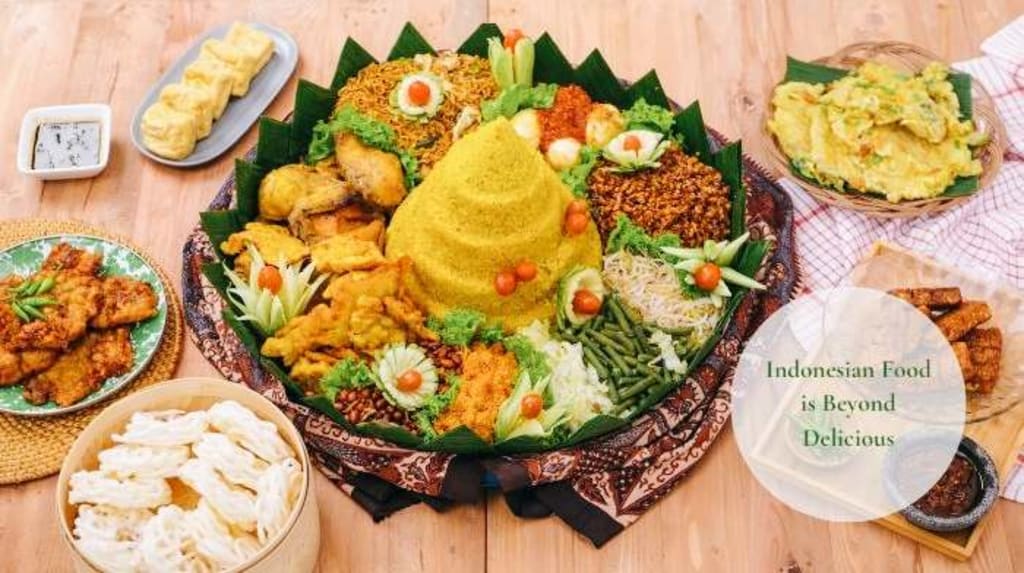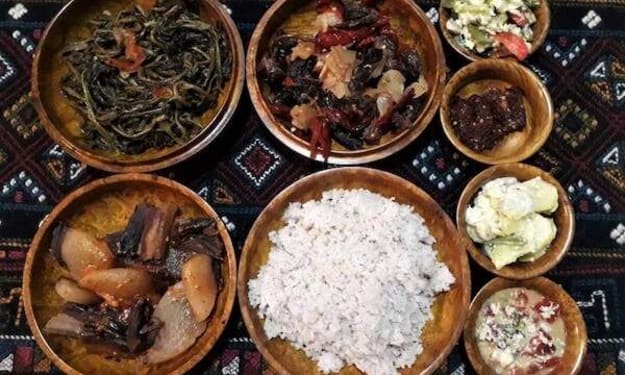The culinary tapestry of Indonesia
A journey through popular foods

Over 17,000 islands make up the Indonesian archipelago, which is home to culinary traditions as diverse as its geography. The vastness of this Southeast Asian nation has resulted in the formation of a diverse and extensive food culture that has been profoundly influenced by the ingredients that are found there, interactions between cultures, and historical trade routes. Indonesian cuisine offers a tantalizing array of flavors, textures, and aromas that captivate the senses, from Jakarta's bustling streets to Bali's tranquil beaches. Cultural and historical influences Trade, colonization, and cultural exchange have shaped Indonesia's culinary landscape for centuries. Many dishes are influenced by Indian, Chinese, Arab, and European traders. Native to the Maluku Islands, spices like cinnamon, nutmeg, and cloves once had such high value that they drew traders from all over the world. The local cuisine was enriched by these interactions, which introduced new ingredients and cooking methods. Indonesian cuisine was also significantly influenced by the Dutch colonial era, which introduced European dishes that were adapted to the local palate. The result of this fusion was one-of-a-kind dishes that combined native and exotic flavors to create a distinct culinary identity. Diversity in Indonesian Cuisine by Region The vastness of Indonesia's territory contributes to its culinary diversity. The ingredients and cultural practices of each region are reflected in the distinctive regional dishes.
Sumatra:Coconut milk and chili are common ingredients in Sumatran cuisine, which is known for its bold and spicing flavors. Rendang, a slow-cooked beef dish with a rich, spiced coconut sauce, is a well-known Padang dish, especially from West Sumatra.
Java:Java, the island with the most people, has a diverse cuisine that combines sweet, savory, and spicy flavors. Gudeg, a young jackfruit stew, is a popular dish in Central Java, while Rawon, a black beef soup, is a popular dish in East Java.
Bali:Balinese cooking is described by its utilization of new spices and flavors. Highlights of Balinese cuisine include dishes like Babi Guling (roast pig) and Bebek Betutu (slow-cooked duck).
Sulawesi:Dishes like Coto Makassar, a beef and offal soup, and Bubur Manado, a rice porridge with a variety of toppings, showcase the island's spicy and tangy flavors.
Maluku and Papua: These islands are famous for their seafood and serve dishes like grilled fish called Ikan Bakar and papeda (sago porridge). The Greatest Indonesian Dishes
Nasi Goreng:Nasi Goreng is a flavorful fried rice dish that is probably the most well-known Indonesian dish. It is usually served with a fried egg, chicken, prawns, and pickles on the side. It can be eaten at any time of day and is a versatile dish.
Satay: Satay is a popular Indonesian street food that consists of skewered and grilled meats that are typically accompanied by a thick peanut sauce. Chicken, beef, lamb, and even tofu are all options.
Gado-Gado is a hearty salad with tofu, tempeh, hard-boiled eggs, blanched and raw vegetables, and a creamy peanut sauce. It is vegetarian-friendly and emphasizes the use of local, fresh ingredients.
Rendang:Rendang is a type of beef stew that comes from West Sumatra. It is made by simmering beef in coconut milk and a variety of spices for a long time until the meat is tender and the sauce is thick and caramelized. It is frequently served at celebrations.
Soto:Meat (chicken, beef, or goat), broth, and vegetables are typically included in this traditional soup, which can take on a variety of regional variations. Soto Ayam, or chicken soup, is a particularly popular variation that is frequently consumed as a nourishing meal.
Tempeh:A staple of Indonesian cuisine, tempeh is a fermented soybean product. It is a good source of protein and can be grilled, stir-fried, or deep-fried in a variety of ways.
Bakso: These meatballs, which are typically made of beef, are served with noodles, vegetables, and occasionally tofu or eggs in a savory broth. Bakso vendors sell this comforting dish to hungry people on almost every street corner.
Culture of Street Food Locally, Indonesian street food is referred to as "kaki lima," which means "five feet" and refers to the width of the food carts. Street vendors sell a wide range of tasty and reasonably priced meals and snacks.
Martabak: This popular street food is available in two flavors: savory and sweet. A thick, pancake-like dessert stuffed with chocolate, cheese, and nuts is the sweet version. The spiced meat and vegetables in the savory version remind one of an omelet.
Gorengan: Gorengan is a variety of deep-fried snacks made with sweet potatoes, tempeh, tofu, and other ingredients. As a quick snack or side dish, these crispy treats are enjoyed by people of all ages. Shaved ice, sweetened condensed milk, a variety of fruits, jelly, and sometimes beans make up "Es Campur," a refreshing dessert. Es Campur is a great place to cool off on a hot day.
Kerak Telor: A spicy omelet made of glutinous rice, eggs, and shredded coconut cooked over charcoal for a smoky flavor is a traditional Jakarta Betawi dish. Food and Festivals in Indonesia In Indonesian festivals and celebrations, food is very important. For instance, during Ramadan, the meal that breaks the fast (iftar) frequently includes a variety of sweets and traditional dishes. Elaborate feasts with a wide variety of dishes are common at religious and wedding ceremonies. Lebaran, also known as Eid al-Fitr, is a significant festival that marks the end of Ramadan. Dishes like Ketupat (rice cakes wrapped in coconut leaves), Opor Ayam (chicken cooked in coconut milk), and Sambal Goreng Ati (spicy liver and potatoes) are shared with friends and family. The Contemporary Dining Scene in Indonesia Indonesia's dining scene has changed over the past few years, and there are now more restaurants and cafes serving up modern takes on old favorites. Fusion cuisine, in which Indonesian flavors are combined with international ingredients and methods, is becoming increasingly popular among chefs. Both trendy cafes and fine dining establishments are flourishing in major cities like Jakarta and Bali. These spots frequently underscore the utilization of top caliber, privately obtained fixings and present dishes in creative ways. The farm-to-table movement, which supports local farmers and promotes sustainability, is also gaining traction.
The Function of Rice in Indonesian Food Indonesian food is based on rice, which is a symbol of both food and prosperity. Not only is it a common food, but it also has cultural significance. Steamed white rice (nasi putih) and more complex dishes like Nasi Uduk (rice cooked in coconut milk) and Nasi Kuning (yellow turmeric rice) are among the varieties of rice that are served. In many parts of Indonesia, traditional methods of farming rice are still used, and rice paddies can be found all over the landscape. The deep cultural connection to this essential grain is reflected in the fact that festivals and rituals frequently pay homage to the rice goddess Dewi Sri. Drinks and Desserts from Indonesia Coconut milk, palm sugar, and tropical fruits are common ingredients in Indonesian desserts, making them sweet and filling.
Klepon: These rice cake balls are coated in grated coconut and filled with palm sugar. The sweet burst that comes from biting into the liquid palm sugar is delightful. **Dadar Gulung**: Dadar Gulung is a popular dessert and snack that consists of a green pancake roll that is stuffed with a sweet mixture of palm sugar and coconut.
Es Teler: is a dessert made of mixed ice, similar to Es Campur, but often topped with extras like avocado, jackfruit, and coconut meat to make it even more scrumptious. Indonesian coffee is well-known all over the world when it comes to beverages. The country's climate and geography make it ideal for growing coffee, and distinct coffee varieties are produced in places like Sumatra, Java, and Sulawesi. For coffee enthusiasts, traditional coffee preparations like Kopi Tubruk (unfiltered coffee) and Kopi Joss (coffee with a piece of hot charcoal) provide unique experiences. Another important part of Indonesian culture is jamu, a traditional herbal drink. Jamu, which is made from natural ingredients like turmeric, ginger, and tamarind, has been a part of Indonesian wellness practices for centuries and is consumed for its health benefits.
In the end The many distinct cultural and geographical features that make up the archipelago make up Indonesian cuisine, which is a rich tapestry. From Jakarta's bustling streets to Bali's peaceful villages, each dish tells a story about the land and its people. Indonesia's food culture is both complex and profoundly satisfying because it reflects a history of cultural exchange and adaptation in its flavors, ingredients, and culinary practices. Indonesian food offers a culinary adventure that is as diverse and vibrant as the country itself, whether enjoyed at a humble street food stall or a high-end restaurant. Indonesian cuisine, which celebrates the unity and diversity of this remarkable nation, promises a journey of discovery and delight for those willing to explore its depths.
About the Creator
Ovijit paul
I am a food blogger and I blog about popular foods from different countries. Hope you like my writings.






Comments
There are no comments for this story
Be the first to respond and start the conversation.